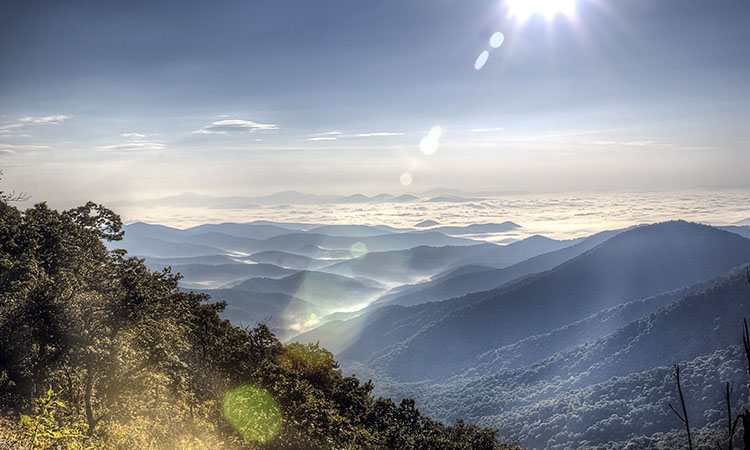Last Updated on April 26, 2023
Long-time locals believe there’s something magical about the Blue Ridge Mountains. Native Cherokee peoples understand them to be sacred and eternal. Even new visitors to Western North Carolina feel there’s something special about this place.
And they’re all right!
The Blue Ridge Mountains stand proudly beneath our feet. But to uncover their history, we have to go deeper, down below the dirt. Here are seven fun facts about the geology of the Blue Ridge Mountains.
1. The Blue Ridge is part of the Appalachian Range
Let’s start with a little geography. The Blue Ridge Mountains are both a part of and distinct from the Appalachians. The Appalachian Mountains are divided into 13 physiographic provinces, of which the Blue Ridge is one. The Blue Ridge, extending across eight states from southern Pennsylvania to northern Georgia, is further divided into north and south regions, which are subdivided into smaller ranges. These smaller ranges include the Great Smoky Mountains, the Great Balsams, the Blacks, the Roans, and even the Brushy Mountains, a “spur” of the Blue Ridge. The Blue Ridge and the Appalachian Valley and Ridge region hugging it to the north and west are separated by a series of thrust faults. The most prominent of these is the Brevard Fault Zone.
2. The Blue Ridge Mountains predate the dinosaurs … by a lot!
The Blue Ridge Mountains are the world’s second oldest mountains, only predated by South Africa’s Barberton greenstone belt. The first mounds of the Blue Ridge Mountains began forming more than 400 million years ago, during the Silurian Period. During this period, the planet saw its first vascular land plants and certain groups of arthropods, including arachnids, became fully terrestrialized. Then, 320 million years ago, the plates that would later form North America and Europe collided to form the supercontinent Rodinia. As the plates pushed together, the land at their edges buckled and rose, like a deck of cards being shuffled together. The Blue Ridge remains as evidence of that collision, as do some areas of the Scottish Highlands. Non-avian dinosaurs wouldn’t walk the planet for another 75 million years.
3. And they were among the tallest in the world
The tectonics that built the Blue Ridge did not stop until the mountains were among the tallest on the planet. At the time of their emergence, the Blue Ridge reached heights comparable to the Alps today—up to 15,000 feet or close to 4,800 meters. The Alps are 100 million years younger, and thus have not weathered as much as the Blue Ridge. Today, the highest peak in WNC is Mount Mitchell at 6,684 feet. It remains the tallest peak east of the Mississippi.
4. Our mountains are “deformed”
Because they were formed by buckling tectonic plates, the Blue Ridge Mountains are made of highly deformed metamorphic rocks. As you may remember from grade school, metamorphic rocks formed from the compressive forces of mountain building. According to the National Park Service, these rock types “include schists, gneisses, slates, and quartzites … extensively intruded by igneous bodies”. The spine of the Blue Ridge, where the plates once collided, is highly metamorphosed, while the piedmont regions flanking the mountains are less metamorphosed.
5. There were never volcanoes in the Blue Ridge …
On several occasions, shearing and folding of the land during the creation of the mountain range allowed magma intrusions to come near the surface before they solidified. Think of bubbles forming in a hot pot of grits that don’t quite break through. Over time, the sedimentary rocks above the intrusions have eroded away. This is why we also see igneous rocks, like granite formations, throughout the region. However, there is no evidence that the magma ever broke the surface of WNC to form volcanoes. There is evidence of widespread prehistoric lava flows in Virginia and Maryland. But those features are a result of continental rifting, not volcanoes.
6. But they WERE once at the bottom of the ocean
The Grenville orogeny is the technical term for the long-running mountain forming event during the Silurian Period that formed the Appalachians. Prior to the plate collisions, there was a warm, shallow ocean along the eastern edges of proto-North America. The sediments along the ocean floor were pushed up, along with everything else, to form mountains. Today, the Great Smoky Mountains still feature coves of flat, sedimentary limestone-floored valleys. These are geologically unique among the other areas of the Blue Ridge, where Grenville-aged rocks are buried by younger overlying sedimentary rocks.
7. Local minerals fuel the Digital Age
The Blue Ridge region offers a wealth of mineral resources. Miners and manufactureres have processed rich deposits of minerals like feldspar, mica, quartz, and gemstones for over a century. Their inclusion in manufacture and industry have contributed significantly to local industries and economies. The 125-square-mile Spruce Pine Mining District is home to one of the richest deposits of minerals and gems in the world. Manufacturers utilize the high-quality quartz found here in silicon chips. The computer revolution may not have developed if not for Spruce Pine.
Locals can learn more about local minerals at the Mineral and Lapidary Museum of Henderson County or from the Colburn Earth Science Collection at the Asheville Museum of Science (AMOS).
Find your Blue Ridge mountain home in Western North Carolina!
With a population of 90,000+, Asheville is the largest city in Western North Carolina. Asheville serves as the area’s economic and cultural nerve center in many ways, including as a hub for education, healthcare, local arts and crafts, entertainment, and innovative food and drink. But surrounding counties and communities offer their own unique charms and abundant opportunities. Best of all, the Blue Ridge Mountains run through the region, offering a four-season temperate climate that makes year-round living easy. And the broad range of elevations—and corresponding climates and plant growth—make it one of the most biodiverse regions in the United States and the world.
Does that sound like the perfect lifestyle for you? Begin your WNC home search by using the Allen Tate/Beverly-Hanks Community Finder.





Hi both Mole Hill and Trimble Knob are technically volcanos, while they are now extinct